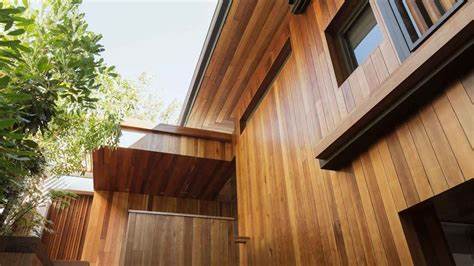As natural wood siding houses become increasingly popular, this introduction invites readers into a world of exquisite craftsmanship and practical benefits. Get ready to explore the beauty and functionality of natural wood siding in the realm of home design.
Delve into the nuances of natural wood siding, from its sturdy characteristics to the diverse array of wood types used in construction.
 Natural wood siding is a popular choice for homes due to its timeless and classic look. It adds warmth and character to a house, enhancing its curb appeal.
There are several benefits to using natural wood siding for houses:
Natural wood siding is a popular choice for homes due to its timeless and classic look. It adds warmth and character to a house, enhancing its curb appeal.
There are several benefits to using natural wood siding for houses:
Overview of Natural Wood Siding Houses
 Natural wood siding is a popular choice for homes due to its timeless and classic look. It adds warmth and character to a house, enhancing its curb appeal.
There are several benefits to using natural wood siding for houses:
Natural wood siding is a popular choice for homes due to its timeless and classic look. It adds warmth and character to a house, enhancing its curb appeal.
There are several benefits to using natural wood siding for houses:
Characteristics of Natural Wood Siding
- Natural wood siding is durable and can last for many years with proper maintenance.
- It is versatile and can be painted or stained in various colors to suit different architectural styles.
- Wood siding is eco-friendly and renewable, making it a sustainable choice for environmentally conscious homeowners.
- It provides natural insulation, helping to regulate the temperature inside the house and reduce energy costs.
Types of Wood Commonly Used for Siding
- Cedar: Known for its natural resistance to insects and decay, cedar is a popular choice for wood siding.
- Pine: Pine is a cost-effective option for wood siding, but it requires more maintenance to prevent rot and decay.
- Spruce: Spruce is another affordable option that can be painted or stained to achieve the desired look.
- Redwood: Redwood is a premium choice for wood siding, prized for its durability and rich color.
Installation Process
Installing natural wood siding on a house involves several steps to ensure a successful outcome. Proper preparation of the exterior surface is essential to guarantee the longevity and durability of the wood siding. Additionally, having the right tools and materials on hand is crucial for a smooth installation process.Preparing the Exterior Surface
Before installing wood siding, it is important to prepare the exterior surface of the house properly. This includes:- Cleaning the surface to remove dirt, dust, and debris.
- Repairing any damaged or rotted areas on the existing siding.
- Applying a weather-resistant barrier to protect the wood siding from moisture.
- Priming the surface to ensure proper adhesion of the wood siding.
Tools and Materials Required
To successfully install natural wood siding, you will need the following tools and materials:- Hammer or nail gun for securing the siding in place.
- Tape measure and chalk line for accurate measurements and alignment.
- Circular saw or miter saw for cutting the wood siding to size.
- Siding nails or screws for attaching the siding to the exterior surface.
- Level for ensuring the siding is installed straight and even.
- Wood sealer or stain to protect the wood from the elements.
Maintenance and Care
Proper maintenance and care are essential for ensuring the longevity of natural wood siding. By following a regular cleaning routine, conducting inspections, and making necessary repairs, you can keep your wood siding looking beautiful for years to come.Cleaning Process
- Regularly clean your wood siding with a mixture of mild soap and water to remove dirt, dust, and other debris.
- Use a soft brush or cloth to gently scrub the surface, avoiding harsh chemicals or abrasive materials that could damage the wood.
- Rinse the siding thoroughly with clean water to remove any soap residue.
- Consider applying a wood cleaner or brightener to maintain the natural color and finish of the wood.
- It is recommended to clean your wood siding at least once a year, or more frequently if you live in an area with high levels of pollution or exposure to harsh weather conditions.
Inspections and Repairs
- Regularly inspect your wood siding for signs of damage, such as cracks, rot, or warping.
- Address any issues immediately to prevent further damage and maintain the structural integrity of the siding.
- Make sure to check for mold or mildew growth, especially in areas with high moisture levels.
- Replace any damaged or rotted pieces of wood promptly to prevent the spread of decay to other parts of the siding.
- Consider applying a sealant or protective finish to enhance the durability and weather resistance of the wood.
Design and Style
When it comes to natural wood siding houses, the design and style play a crucial role in enhancing the overall aesthetic appeal of the property. Let's explore different design options and tips for choosing the right wood siding style based on architectural design.Different Design Options
- Vertical Siding: Vertical siding can create a sense of height and grandeur, making it ideal for traditional or farmhouse-style homes.
- Horizontal Lap Siding: This classic style is versatile and works well with various architectural designs, from modern to colonial.
- Board and Batten: A rustic and charming option, board and batten siding adds texture and visual interest to the exterior of a home.
Choosing the Right Style
- Consider the architectural style of your home: Match the wood siding style to the overall design of your house for a cohesive look.
- Take into account the surroundings: Think about the landscape and neighboring homes to ensure the wood siding complements the environment.
- Think about maintenance: Some styles may require more upkeep than others, so choose a style that fits your lifestyle and maintenance preferences.
Incorporating into Modern or Traditional Designs
- For modern homes, opt for sleek and simple wood siding styles like horizontal lap siding or shiplap to achieve a clean and contemporary look.
- Traditional homes can benefit from classic styles like board and batten or cedar shake siding to maintain a timeless and elegant feel.
- Mix and match: Don't be afraid to mix different wood siding styles to create a unique and personalized exterior that reflects your taste and style.













